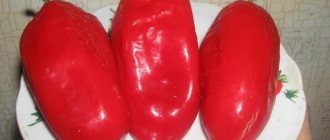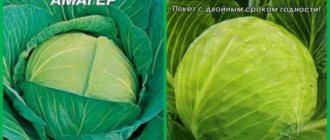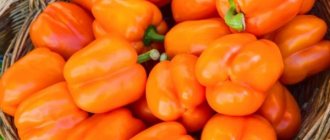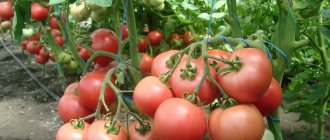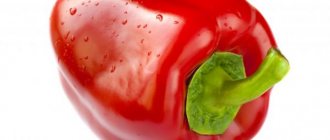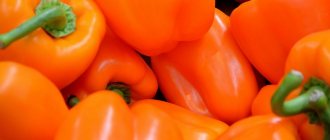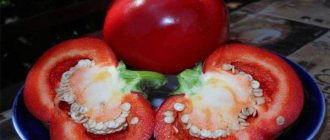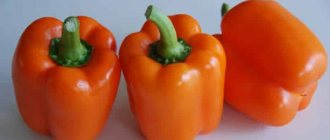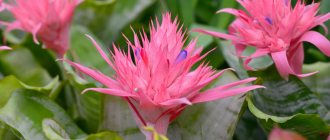What kind of pepper is this
The f1 hybrid is grown in a greenhouse, hotbed or open ground. It is unpretentious in care, so even a novice gardener can get an excellent harvest.
As befits a hybrid, Chanterelle is characterized by stable productivity and resistance to pests and diseases. The vegetable got its name from its bright orange color. Purchase seeds only from trusted stores.
Peculiarities
The hybrid is early ripening: ripens on average 120 days from planting . The bushes are low, about 70 cm in height. Peppers are planted on hilly and sunny beds: in such conditions the crop will show the best results.
Interesting! Chanterelle is an amazing hybrid. Many people grow it at home on a balcony or windowsill. The main thing is to prepare the soil and a suitable container in advance.
Fruit characteristics and yield
The shape is cone-shaped, the surface is glossy, orange in color . The weight of the fruit varies from 30 to 50 g, there are few seeds. The walls are dense, up to 7 mm thick. The flesh is fleshy, the aroma is sweet. Due to its small size and juicy taste, Chanterelle is excellent for whole-fruit canning and stuffing. About 3 kg of beautiful and sweet vegetables are harvested from 1 m2.
Important! After harvesting, peppers are stored in the refrigerator or cellar. The hybrid remains elastic for a long time and does not lose its taste and commercial qualities.
CHANGER PEPPER, GUARANTEED HARVEST OF SWEET CHANTERELLE PEPPER
Description of pepper Chanterelle F1, reviews, photos
Mid-early, original, small-fruited sweet pepper for growing in open ground, film tunnels, at home in pots and containers.
The period from full germination to the beginning of the technical stage of ripeness is 100-105 days. The bush is low-growing, semi-standard, compact. The leaf is medium sized, green, wrinkled. The position of the fruits on the plant is drooping.
The sweet pepper variety Lisichka is included in the State Register of the Russian Federation.
Fruit characteristics
The fruits are cone-shaped, smooth, glossy, small, green at the stage of technical ripeness, orange at the biological stage, weighing 25-45 grams, sweet, with a piquant spicy aroma. Wall thickness 5-6 mm.
The fruit is cone-shaped, smooth, glossy, green at the technical stage of ripeness, orange at the biological stage. Number of nests 2. Fruit weight 25-45 g, wall thickness 5-6 mm. The taste is excellent, the aroma is strong.
Yield of Chanterelle pepper: 2.1-2.5 kg of fruits per 1 sq. meters of planting (subject to watering and fertilizing).
Advantages of the hybrid: original shape and color of the fruit, high taste, disease resistance.
Preparation for cultivation
You can only grow crops in well-prepared and nutritious beds . To do this, in the fall, they choose a place for future planting and clear the ground of debris and weeds.
Pepper feels comfortable in well-fertilized soil, so after digging, fertilizers containing phosphorus, magnesium and calcium (for example, potassium salt or superphosphate) are added to the soil. With the arrival of spring, the beds are dug up again and row spacing is created. The recommended planting pattern for Chanterelle is 30x50.
Important! To improve the quality of the soil, a mixture of dry wood ash and lime is added to the beds. Liming reduces the acidity of the soil and saturates it with nutrients.
The seeds of the hybrid are already pre-treated by the manufacturer , but some gardeners carry out another disinfection using a solution of potassium permanganate. This is necessary to increase seed germination and provide additional protection from pests and diseases.
Growing seedlings
Hybrid seedlings are prepared in early March . To do this, purchase seedling containers and soil in advance. Peat tablets, flower pots, and thick plastic bags are used as containers. Before planting, the container is thoroughly washed with soda and wiped with a dry, clean towel. As soil, use disinfected soil from the garden or ready-made store-bought mixtures. Peat, humus, compost or wood ash are added to the soil.
Important! According to its structure, loose and light soil is chosen so that the roots receive oxygen. Also, there should be no weeds, debris, or larvae in the soil.
Caring for seedlings consists of several procedures . First of all, this is regular watering. It is recommended to moisten the soil using a pipette, directing the water directly under the root. This will prevent the appearance of fungi and dangerous microbes. 15–20 days after planting, the peppers are fertilized with liquid organic matter (for example, bird droppings). For healthy development, seedlings are placed in a warm and sunny place. If there is a lack of light, use phytolamps or fluorescent devices.
As soon as the seedlings have 1-2 true leaves , they are picked (transplanted into a larger container). This is an integral stage of care, since as the bushes grow, they require more space, moisture and nutrients. Picking requires new container and soil. The sprouts are carefully removed using a small spatula and placed in a container. The stem is sprinkled with earth and watered abundantly.
About other varieties of pepper:
Juicy and productive Red Bull pepper
Large and sweet pepper variety "Big Girl"
Features of the salad pepper variety “Bugai”
Landing Features
Growing seedlings
Chanterelle is an early variety. Peppers ripen 2.5-3 months after planting the seedlings. Therefore, it is recommended to plant seeds in early March. Since the variety has low germination, the seeds must be prepared in advance. To reject bad grains, prepare a saline solution. A tablespoon of salt is diluted in a liter of water and the seeds are placed in it. The bad ones are those that remain on the surface of the liquid. They need to be thrown away. The grains that have sunk to the bottom are planted.
The soil is purchased in specialized stores or prepared independently. It is necessary to mix part of sand, turf and garden soil with 4 parts of peat. The earth is placed in pots or containers and the seeds are planted to a depth of 0.5 cm. They are sprinkled with earth and watered. Cover the containers with film to create a steam effect.
As soon as the sprouts hatch, the covering is removed and the containers are placed in a sunny place. Peppers should grow in them until the plants have 3-5 true leaves. After this, the plants are picked, transplanting each into a separate, more spacious pot.
Plants need to be watered as the soil dries out. Drip watering is carried out so as not to damage young plants. It is also necessary to carry out one fertilizing with mineral fertilizers.
Planting seedlings
Seedlings are planted in open ground in late May. It is during this period that spring frosts occur. But anyway, after planting, the peppers are covered with film, which is completely removed in mid-July.
It is advisable to choose beds where crops such as cabbage, legumes, pumpkin, cucumbers, and perennial herbs previously grew. The crop will develop well if you plant corn, garlic, onions, parsley, dill, and basil nearby.
Peppers are planted at a distance of 25 cm from each other. If rows are formed, the distance between them should be approximately 50 cm. Holes are made in the ground 7 cm deep. Plants are planted so that the lower leaves are above the soil surface. The seedlings are sprinkled with earth and watered.
Planting in open ground and further care
Seedlings are sent to the greenhouse in mid-May, to open ground - 2-3 weeks later . 10 days before planting, the bushes are watered pointwise to avoid waterlogging. Holes are prepared in the beds into which the sprouts are placed and sprinkled with loose soil on top.
It is recommended to replant peppers on a cloudy and windless day to avoid sunburn on the plant.
Further care consists of the following procedures:
- . Bell pepper loves water , but it is not recommended to over-moisten the soil: this leads to diseases. Irrigate the beds in the morning or evening when there is no sun. Otherwise, the water will quickly evaporate and the earth will crack. About 1 liter of warm water is consumed for 1 bush. The procedure is carried out once every 5 days.
- Fertilizers . Alternate mineral and organic fertilizers. Chanterelle pepper reacts positively to superphosphate, ash, and ammonium nitrate. Fertilize the bushes before watering, once every 10–15 days.
- Bush formation . The plant produces many small fruits, so it is necessary to remove weak shoots in a timely manner. Thanks to its formation, the bush spends its energy not on the growth of green mass, but on the development of the fruits themselves.
- Loosening the earth . Carry out before each watering. This makes the soil lighter and airier and prevents the appearance of pests.
Care Tips
Peppers take root much worse compared to other vegetable crops, so they need to be watered more often, and also monitor the growth dynamics of the tops and the condition of the soil in which the crop grows.
Watering
For the full development of sweet peppers, it is necessary to water the garden bed twice a week. It is advisable to pour 1.5–2 liters of warm, settled water under each root. In hot weather, as well as during the harvesting period, moistening is carried out daily, avoiding waterlogging and drying out of the earthen coma.
Read more about how to properly water peppers in a greenhouse.
Many vegetable growers have replaced the manual type of watering with mechanical and automated designs. Drip installations are especially popular, which allow you to regulate the level of humidity in the greenhouse and in the garden without the expense of physical resources.
Soil care
After each watering, the soil must be loosened, thereby preventing the formation of a hardened crust. As weeds appear, the importance of weeding the garden beds increases. Such neighbors are extremely undesirable because they suppress the growth of vegetable crops, deplete the soil, and attract pests.
During the period of active growth, the plant needs to be hilled. This is done carefully, since the roots of nightshade crops painfully endure any damage and take a long time to recover.
Mulch the bed with a layer of rotted straw, about 10 cm thick. This is done to prevent the evaporation of soil moisture and the growth of weeds.
Important! Immediately before planting seedlings, fresh manure should not be applied.
.
Top dressing
2 weeks after transplanting the seedlings, when the adaptation period ends, you can add nutrients to the soil. During the season, the crop is fed with fertilizers no more than 4 times with an interval of 12–14 days. It is important to alternate mineral and organic fertilizers, as well as monitor the development of the plant.
For the first time, a solution of:
- ammonium nitrate (5 g);
- superphosphate (0.3 g);
- potassium chloride (1 g).
As an alternative, you can take any complex mineral fertilizers for vegetables (in a proportion of 20 g per 10 liters of water).
Also effective is an infusion of stinging nettle, which is prepared from 1 part of biomass and 10 parts of cold water. Subsequent feedings involve doubling the proportions used.
If the pepper foliage begins to curl, and a dry border appears on its edges, there is not enough potassium in the soil. This component requires special care, since if it is in excess, the crop will wither.
A deficiency of nitrogen-containing substances is obvious from the matte surface of the leaves, as well as their shallowness and grayish tint.
Phosphorus is required when the inside of leaf blades turns purple.
With a lack of magnesium, the foliage becomes marbled.
Did you know? Chocolate and sweet peppers have common properties. Both of them “release” endorphins, the so-called “hormones of happiness,” into the blood.
Features of cultivation and possible difficulties
During the growing process, special attention is paid to weeding the beds . Larvae and insect pests are removed along with the weeds. Weeds suck all the nutritious juices out of the pepper, causing the fruits to wither and lose their taste. Weeds should be pulled out before they develop a strong root system, otherwise it will be much more difficult to remove them. It is better to carry out the procedure after rain, since it is easier to get grass from damp soil.
With a deficiency of minerals, plant development deteriorates . For example, with a lack of nitrogen, the bush develops slowly, the stems become thin and weak, and the leaves acquire a pale green color. Feeling the need for phosphorus, the leaves turn purple-brown and the fruits dry out. The application of mineral fertilizers will correct the situation.
Typical diseases and pests
Although the hybrid has a high immunity to disease , occasionally the bushes are affected by powdery mildew or root rot. The cause of the disease lies in improper care, contaminated seeds or soil. Powdery mildew appears as a white coating on the leaves, which becomes larger over time. Prevention of its occurrence is spraying with iodine and whey. Previkur is used for treatment.
Root rot appears due to increased acidity of the soil or violations of the rules for growing seedlings. The plant becomes lethargic and yellow-brown dents appear on the stem. The root collar darkens and soon turns black. As a preventive measure, the soil in the greenhouse is disinfected and the bushes are regularly fed with organic substances. Root rot is treated with Bordeaux mixture or copper sulfate solution.
Among the pests found in garden beds are nematodes—miniature underground worms . Because of them, the stems curl and the leaves turn yellow and dry. To protect peppers, follow the rules of crop rotation and regularly weed. If the pest has already been noticed in the beds, the drug “HOM” is used to combat it.
Advantages and disadvantages of a hybrid
Bell pepper Chanterelle has a beautiful and bright color - orange vegetables look attractive on the table and are used to prepare various dishes. The fruits are used to prepare stews, casseroles, snacks, canned and fermented dishes.
The high content of fiber, vitamins and other useful components makes pepper indispensable for preparing dietary dishes. Chanterelle requires a minimum of time and effort to care for; the bushes do not need to be tied up or pinched. The harvest is perfectly stored after harvesting: just place it in a cool and well-ventilated place.
Important! Pepper contains vitamins A, E and C, as well as acids and beneficial essential oils. Thanks to such a useful composition, regular consumption of the vegetable improves immunity and serves as a preventive measure for many diseases.
The disadvantages of the hybrid include low yield . Chanterelle is great for growing in small garden plots, but nothing more. Otherwise, the vegetable performs well.
Description and characteristics of the variety
Yellow chanterelle pepper belongs to the group of early species. Fruiting begins after 110-115 days and lasts a long time. Tying occurs abundantly and friendly.
The new variety from “Gavrish” is well adapted to different conditions, but it is best to grow compact peppers on windows in pots and containers. This way, juicy peppers will always be at hand, and elegant bushes will decorate the room and give the home eco-motives in the interior.
The plants of the variety are small, 30-45 cm long. They have moderate branching and a semi-spreading form. Fruits with a pronounced glossy shine hang from the clusters like golden suns.
What you should know about peppers:
- weight 20-35 g;
- length 4-5 cm;
- color green;
- the skin is shiny and durable;
- the taste is sweet (due to the high level of sugars).
These peppers will serve as an excellent fresh snack. They look original preserved in jars whole. They are great to bake or fry for healthy side dishes. You can prepare not only sauces and dressings from the fruits, but also colorful salads.
Reviews
Reviews about the hybrid are mostly positive , but some summer residents were disappointed with the result.
Roman, Moscow: “I grow Chanterelle sweet pepper only in a greenhouse. The bushes are compact and easy to care for. The fruits have a pleasant taste and small size; they make tasty and healthy preparations for the winter. I recommend it for cultivation."
Polina, Anapa : “I planted peppers for the first time. She took care of it as it should be: she watered it and fertilized it with organic matter, and did not forget about weeding. However, the hybrid developed slowly and the fruit set poorly. I think the reason is that the summer was too rainy. The harvest turned out to be meager, I’ll try to grow Chanterelle again next year.”
Lilya, Ufa : “The Chanterelle pepper, in my opinion, has average taste. However, the appearance is excellent, it looks very beautiful both in the beds and on the table. It's easy to grow."
Features of agricultural technology
To grow a hybrid in a greenhouse or open ground, you must first prepare the seedlings. At home, peppers can be cultivated on a windowsill by direct sowing in a container with soil. Agrotechnical nuances:
- seeds are sown in holes 0.8 cm deep;
- growing seedlings for a greenhouse begins 2 weeks earlier than for an uncovered bed;
- seedlings are placed in a permanent place 60 days after germination;
- pepper is watered 2 times a week;
- fertilizing is applied every 14 days;
- the formation of bushes consists of eliminating shoots before the first branching; further pinching is not necessary.
Advice. To give the vegetable juiciness and rich taste, fertilizing during fruit growth should be done with potassium fertilizers.
Sowing seeds for seedlings | Planting seedlings in a greenhouse/greenhouse | Planting seedlings in exhaust gas | Stepsoning | Harvesting |
| End of February - March | 1st ten days of May | End of May - June | Only up to the first fork | Since July |
| *dates are indicated for central Russia | ||||

